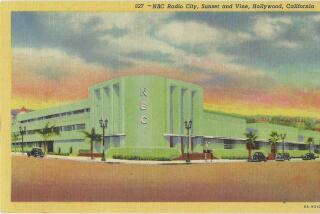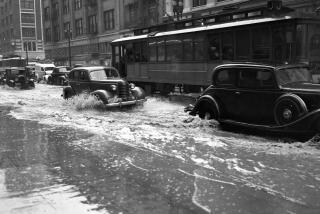All-Weather Radio Station Draws Devoted Fans : Meteorology: Continually updated reports began in the spring of 1967 and have been on the air around the clock ever since.
- Share via
It’s time for the weather here at Oxnard’s KWO-37 radio.
In the broadcast booth, announcer Dennis Seto cues a tape into the console, switches on the microphone and, in a rough-hewn voice with a lively Texas twang, recites a litany of temperatures, wind speeds and sky conditions to an audience of Southern Californians along 250 miles of coast, 125 miles out to sea and 100 miles inland across mountains and deserts.
It’s all the weather all the time at the National Oceanographic and Atmospheric Administration Weather Radio in a high-tech station at 520 N. Elevar St.
For Southern Californians with boats, outdoor jobs or a fascination with nature’s unending panorama, KWO-37 provides no-frills temperatures and forecasts direct from the National Weather Service.
By the thousands--the exact number is elusive but was once estimated at 2% to 10% of the Southland population--listeners tune in on police scanners or specialized weather receivers widely available at electronics stores starting at about $20.
The station’s one and only radio program of continually updated weather reports began in the spring of 1967 and has been on the air around the clock ever since, said meteorologist and spokesman Tim McClung.
Taking turns at the mike are 30 staff forecasters and technicians. They aren’t Hollywood-slick, their script isn’t glamorous, and they play no music, sports or commercials. But that suits their listeners just fine.
Scott Miller, assistant harbor master for the Port of Ventura, is a devoted Weather Radio fan because “they give you the raw data when you need it. They don’t tell jokes and they don’t shoot the (bull).” He said every boater he knows carries a scanner tuned to the Weather Radio.
*
Seto, a 17-year veteran of the Weather Service, added his folksy two-minute hourly update to a loop that includes coastal, mountain and desert forecasts, long-range forecasts and marine reports. Total running time: eight minutes, 30 seconds.
The tape plays over and over until updated the next hour or until an announcer hits a red button on the console that interrupts it, sending out a signal warning of dangerous conditions such as flash floods or high winds. The signal is heard on specially equipped radios even if they’re switched off, a technical trick from the mid-1970s developed to warn of nuclear attack.
Unashamedly unpolished as radio personalities, the Oxnard staff, many of whom came here when the National Weather Service regional office moved a year ago from Westwood, takes pride that the more glamorous commercial weathermen and women tune in their broadcasts and even call to chat about the weather.
Dallas Raines, meteorologist at KABC-TV, Channel 7 Los Angeles, admits being a daily listener.
“They do a really great job,” said Raines, who has a VHF receiver in his car tuned to Weather Radio. “But if we provided all that technical data, we’d lose a lot of our audience.”
Mariner Louis Abbott at Ventura Harbor is grateful for the no-nonsense delivery.
Abbott, who has been sailing coastal waters most of his life, turns on KWO-37 before opening his sport-fishing business at 4 a.m. By then, he knows where to send his boats for the day.
A flotilla of automated offshore buoys transmits wind-speed and ocean-swell data back to Oxnard, where the announcers put it on the air starting at 3 a.m.
“It can be still as heck here at the harbor, but out 16 miles it’ll be blowing 30 knots from the west,” said Abbott. Anticipating such a wind, he can send his vessels leeward of the Channel Islands to fish calmer waters.
*
Whereas mariners are an easily identifiable audience, counting inlanders who tune in has been a daunting task.
Ken Putkovich at National Weather Service headquarters in Silver Spring, Md., said the service recently commissioned new detailed surveys to try to pin down the exact audience of the 400 NOAA Weather Radio stations across the country. No commercials are sold on the broadcasts, so without the need to count listeners for ratings points, nobody has ever done it.
But a sure sign of the number of listeners is the complaints that pour in whenever NOAA stations malfunction. “We even hear it through congressmen,” Putkovich said.
McClung said KWO-37 hears regularly from its listeners, 400 of whom have joined an informal network of weather spotters, calling in to describe phenomena such as high winds, snow or locally heavy rainfall.
Listeners also call in with the offbeat. They report sightings of meteors and flying saucers, and many want to hear the latest earthquake forecasts. They are all treated politely and, when possible, referred to other federal, state or local agencies. Those who want to come and take a look around are invited for a tour, McClung said.
He also hears complaints, often from listeners who never hear enough about the weather in their climatic zone. “People who live in the mountains always want to hear more about the mountains,” McClung said.
The Weather Service, which regularly transfers forecasters from station to station, has a bit of criticism for Southern California, too.
“The summers are too warm down here,” said Oxnard technician Bruce Rockwell, who moved south in July after four years in Nome, Alaska.
“And sometimes,” said McClung, who transferred from Salt Lake City, “I get in the mood for a nice big snowstorm.”
More to Read
Sign up for Essential California
The most important California stories and recommendations in your inbox every morning.
You may occasionally receive promotional content from the Los Angeles Times.










